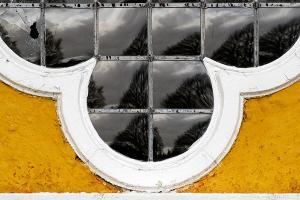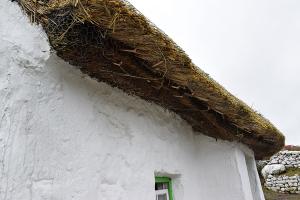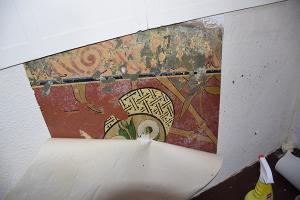The following advice should be read for information and advice on the use of paint including lead paint in heritage buildings, and the necessary permissions required for the use of lead paint in Northern Ireland. Any work to designated buildings should be carried out by tradespeople suitably accredited and/or experienced in conservation works under the guidance of professionals suitably experienced and/or accredited in conservation.

Historical Note
All paints consist of three basic ingredients – pigment, binder and solvent.
Before the 17th century all but the simplest most basic paintwork had been reserved for decorative interior work. External painting generally made use of earth pigments such as lime, umber and ochres and durability was not a prime factor. These materials were all used in water solutions. A basic change took place when native timber supplies were exhausted and European red and white pine became the common materials for windows and doors. Paint now had to be used for protection and had to be durable. Oil took the place of water and since the paint was to last longer, more care had to be taken in the selection and preparation of the pigments. These early oil paints were ‘flat’ (matt), but were sometimes given a gloss finish by applying varnish over the paint. Painters ground their own pigments and mixed their own paint, with the result, because of the toxicity of so many of the materials used, a painter’s life was notoriously short.
The use of water based paints for walls remained universal until the advent of oil based stucco and Roman Cement renders. Even these were at first either self-coloured or painted with water based paints but increasing pollution of the atmosphere caused practice to change so that from early in the 19th century town buildings have been painted mainly with oil based paints.
Since the Second World War a fundamental change has taken place in the formulae and manufacture of paints. The one common characteristic is an increased impermeability, which can be a serious problem when choosing suitable materials to decorate buildings with solid walls, particularly early walls which have no damp-proof courses.
Faults and Repair
A great deal of original paintwork survives, very often covered by a failing application in more modern times.
Paint failures fall into two basic groups:
- Failure apparent soon after application - usually due to one of the following reasons:
- In the case of redecorating old surfaces poor presentation can leave old flaking paint, dirt, grease, damp, or mould growth. Failure can also be due to the new paint having a totally different physically characteristic to the paint onto which it is applied; a common example of this follows the application of dense resin vinyl or latex based paint onto a weak water soluble paint surface;
- In the case of decorating new work the most common faults are caused by insufficient time being left for the underlying surface to dry out; the fluid may be water or the solvent in a wood preservative treatment. This condition is aggravated when heat is introduced after decoration, especially if the fuel used by the heater produces moisture during combustion (e.g., paraffin or gas);
- Faulty priming, sealing of knots, et
- Failures after the paint has had time to mature. All paints have a limited life span. This period of time varies widely depending on paint type, care in preparation and application and climatic conditions.

Harsh climatic conditions will accelerate this process as well as the more obvious effects of wind and rain; sunlight will bleach colours and sometimes cause blistering and cracking. Blistering in sunlight is usually due to substances melting in the heat behind the paint surface, for example, resin in timber knots or old varnish disguised by later paint. Sunlight will also be destructive where overpainting has left a series of absorbent and reflective colours overlaying each other causing local heat to build up due to relatively different expansions within the paint film itself. It is very common to find an 18th century reflective lead-based paint, over painted with a dark 19th century layer and finally a reflective modern application; such a combination does not stand much chance in direct sunlight conditions.
When assessing paint failure always check that the backing of timber, metal or plaster is sound. Failure on the surface is often a system of failure below and until the root cause is corrected, every future coat of paint will have a limited chance of survival.
Where a paint film has failed, there is no alternative to stripping back to a firm surface. This process offers a unique chance to record the history of decoration in an old building.

Whatever is found should influence the choice of redecoration. The stripping process itself must be carefully executed. Modern warm air strippers are good, they keep dust to a minimum and do not damage the underlying features, mouldings, etc. Chemical strippers can be used for oil based paints but beware of the caustic varieties. Caustic salts can build up in the surface of timber and plaster resulting in later damage to the newly applied paint. Remember that lead dust is highly toxic so that the rubbing down of the old lead paint must be done using wet abrasive papers or wet sugar soap – remember too when decorating that lead based paints are only toxic if they get into the mouth.
There are no toxic fumes from new paint. If the failure in the paint is due to defects in the material on to which it is applied, i.e., damp, rot efflorescence, weeping knots, rusting etc, then these must be all attended to first. There are a wide variety of modern preparatory dressings – epoxy binders, anti-suction primers, alkali resistant primers, fungicidal washes, rust arresting preparations, etc. When considering the use of any of these preparations it is a wise precaution to consult the technical advisory section of the manufacturer of the paint that it is intended to use in subsequent applications. One rule always applies, never seal damp into a wall – or simply paint over defects. If you do, your problem will gradually get worse. When you have to decorate onto walls that do reach relatively high saturation levels use only porous paints. For external use paints with this quality are lime based, cement based or silicate based. Be wary of builders who give low prices for decoration. You are likely to be given poor preparation and/or low quality paint. Either or both will result in a much shorter life than would otherwise be the case.
For regular preventative maintenance external paintwork should be inspected every three years and certainly no less than every five, and the necessary redecoration put in hand. Internal paintwork will have a life varying with the style of use or abuse to which it is subjected. It is not performing a protective function and therefore is not critical except in terms of appearance. When choosing decorative schemes be selective not only over the clinical composition of the paint but also texture and finish. Textured paints are all recent innovations and alter the appearance of older buildings. So called ‘natural finishes’ are also innovations. They are generally only suitable for hardwoods, the use of which for external joinery is practically unknown during the 18th century and most of the 18th century; they also have a relatively short life and therefore are more costly to maintain than opaque paint.
Notes on the Preparation of Contract Specifications
- Describe which surface are to be treated;
- surfaces for redecoration.
- new surfaces receiving their first decoration.
- Describe protection for adjacent surfaces, and methods of preparation to be used. No application of paint should be made until the owner or his consultant has inspected the prepared surfaces.
- If older decorative schemes are to be investigated by scrapes, etc, this should be stated.
- If sample areas are to be provided before a final choice is made for the final decoration, describe what is to be done and where.
- Describe any required surface treatments or repairs in advance of painting.
- Describe the types, manufacturers and colours of the paints to be used, the number of coats and the preparation between coats. Finally describe the protective measures to be taken.
NOTE – if there is any technical advice necessary from the paint manufacturers or advisory bodies it should be obtained by the owner or the professional consultant, not left to the painter. Any such information received must be made freely available to the painters themselves while they are working.
Health and Safety
Be aware of Health and Safety concerns and take appropriate measures. Manufacturers often will produce guidance, however health and safety management and responsibilities relating to projects involving lead paint fall to those fulfilling the client /owner and principal designer roles (as laid down under the CDM Regulations). The principles of the CDM Regulations apply to all construction works and not just large or notifiable projects. Therefore, project teams are responsible for risk assessments, method statements, Health & Safety Works Phase Plans and specific risk assessments pertaining to any potentially hazardous substance (such as lead based paint) or dusts produced by processes such as sanding down etc.
Lead paint
The marketing and use restrictions of lead paints are set out in the REACH Enforcement Regulations, Schedule 5 (and specifically UK Statutory Instrument No.2852). REACH, is the acronym for the Registration, Evaluation, Authorisation and Restriction of Chemical substances.
It restricts the use of hazardous substances and promotes the safe handling of all chemical materials. It is an offence to contravene paragraph 5(b) or 6 of Part 1 of Schedule 5, or cause or allow another person to do so.
A person/supplier who supplies or uses lead paint is subject to the following restrictions and obligations.
Permitted use of lead paint
In Northern Ireland a supplier can, with the approval of the Department, supply lead paint to be used in the maintenance or restoration of:
- All listed Buildings regardless of grade
- Scheduled monuments
Suppliers wanting to import and/or sell lead paint must comply with REACH regulations.
As described above, lead paint can be used under permit for all listed buildings in Northern Ireland. The permit scheme is self-certifying. In Northern Ireland Potential users must write to The Department for Communities requesting permission for the use of lead paints.
The Department will certify to the paint manufacturer that the intended use is for one of the categories exempted under the legislation i.e. a Northern Ireland listed building or scheduled monument.
The advantage of lead to a historic building is that the colour is more historically accurate, the paint has properties which are beneficial to the timber (linseed oil base), and the material weathers by ‘dusting’ which maintains colour and does not trap moisture. Such paint would have been used widely until the 1960s, its use is now limited because of concerns over the toxic nature of some of the ingredients.
Lead paint purchased in the UK
If you want to use lead paint for qualifying structures in Northern Ireland you must obtain a declaration form from the supplier of the paint, complete it, and send it back to the supplier.
The supplier must then send a copy of the declaration with their own notification form to The Department for approval. The required contents of the declaration and notification forms and the contact details of the Historic Environment Division (HED) of the Department for Communities are set out below. The supplier must not supply the paint less than three weeks after submitting the declaration and notification forms to The Department.
Upon receiving the declaration form from the supplier, HED will assess the eligibility of the sale of paint. If we are not satisfied with the content of a relevant declaration or notification, we will respond in writing to the applicant within two weeks of receipt, with the reasons for our decision.
Lead paint purchased outside the UK
If you have obtained lead paint outside the UK and want to use it in Northern ireland you must complete and send a declaration form with the information listed below (Contents of a relevant declaration) to HED. You must not use the paint less than three weeks after submitting the declaration
Upon receiving the declaration form, HED will assess the eligibility of the proposed use. If we are not satisfied with the content of a relevant declaration, we will respond in writing to the applicant within two weeks of receipt, with the reasons for our decision.
HED contact details for lead paint declarations and notifications
Contents of a relevant declaration
- The name, address and telephone number of the intended user of the paint.
- The quantity, trade name and manufacturer of the paint intended to be used.
- In the case of a listed building, the name, address and owner of the building
- In the case of a scheduled monument, the name, location and owner (if known) of the monument.
- In the case of a listed building or scheduled monument, details of the parts of the building or monument where the paint is to be applied.
- The date the declaration is made and the signature and name of the person making it.
Contents of a notification
- The name, address and telephone number of the intended supplier of the paint.
- A statement that the intended supplier agrees to supply to the intended user paint of the quantity and type stated in the relevant declaration.
- The date the notification is made and the signature and name of the person making it.
Paints with high volatile organic compounds (solvents)
- Organic solvents in paints or volatile organic compounds (VOCs) react in sunny conditions with nitrogen oxides to form ozone which is harmful to health and vegetation.
- Paints affected include:
- Oil gloss paints
- Flat oil and eggshell oil paints, and
- Many oil-based varnishes
Their use is restricted (European Legislation Directive 2004/42/CE and Paints, Varnishes and Vehicle Refinishing Products Regulations (Amendment) (England) 2009 SI 3145).
However, the legislation does permit the use of decorative paints, varnishes with a higher VOC content for the maintenance of historic buildings that are either Grade I, Grade II* or a scheduled monument.
A Code of Practice governs the sale of non-compliant paint to customers for use on historic buildings or vintage vehicles. The supplier requires the customer to complete a declaration of intent and proof of historic building status. The declaration form can be obtained from the paint supplier.
Bibliography
- Sourcing lead paint – Historic England
- REACH - Chemicals - Environment - European Commission
- The Volatile Organic Compounds in Paints, Varnishes and Vehicle Refinishing Products Regulations 2005, statutory instrument number 2005/2773)
- Building Research Establishment Digests (withdrawn & archived)
- Digest 197 - ‘Painting Walls: Pt 1 Choice of Paint’
- Digest 198 - ‘Painting Walls: Pt 2 Failures and Remedies’
Other Publications
- Lead Paint Regulations 1927 (HMSO) [officially superseded but very practical as a guide].
- Painting and Decorating – by H E Hurst and G H Goodier (9th Edition 1981).
- Your House – the Outside View – by John Prizeman 1982.
- Mortars, Renders & Plasters, Practical Building Conservation series, English Heritage, 2012
- Practical Building Conservation Vol. 3, Mortars, Plasters and Renders. 1988. John & Nicola Ashurst.
- The Georgian Group Guides No4, Paint Colour, 2018
- Paint. The Society for the Protection of Ancient Buildings (SPAB)
- Inform Guide: Interior Paint. A guide to internal paint finishes. Historic Scotland 2007
- Inform Guide: Decorative Paint Finishes: Graining and Marbling. Historic Scotland 2010
NOTE - all the major manufacturers maintain a Technical Advisory Service. If in doubt of an address to contact refer to either the Paint Research Association
Contractors
The Department cannot recommend specific contractors for restoration work. However, this is a skilled field and owners and their agents should satisfy themselves that those they employ have the required skills. Previous examples of their work should be inspected, and recommendations sought.
UK and Ireland contractors who claim to have restoration experience are now listed online; The Directory of Traditional Building Skills, compiled and published by Ulster Architectural Heritage in association with HED can be accessed via the UAH website.
The Irish Georgian Society publishes a list of specialist contractors based mainly in the Republic of Ireland.
